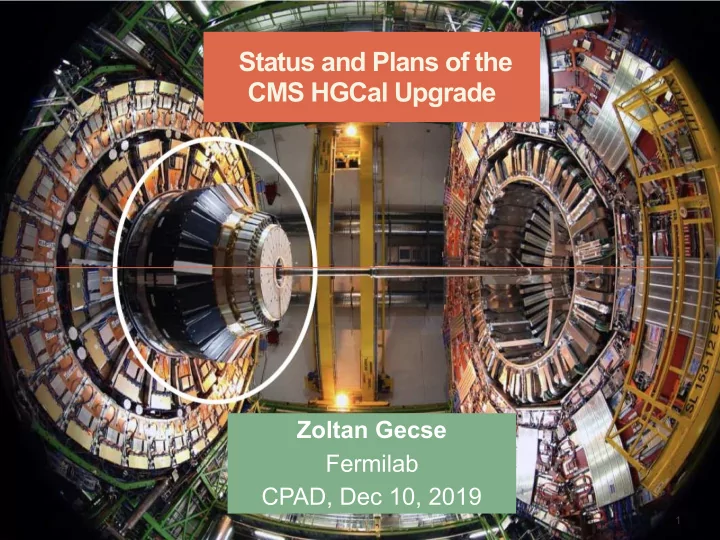

Status and Plans of the CMS HGCal Upgrade Zoltan Gecse Fermilab CPAD, Dec 10, 2019 � 1
The High Luminosity LHC CPAD 2019 Zoltan Gecse � 2
Radiation Challenge CPAD 2019 Zoltan Gecse � 3
Technology Choices • Dissipated power ~250kW • Removed with two-phase CO2 cooling operated at -35C CPAD 2019 Zoltan Gecse � 4
Silicon Sensor Layout CPAD 2019 Zoltan Gecse � 5
Hexaboards and Module Assembly CPAD 2019 Zoltan Gecse � 6
Scintillator Tiles and SiPMs CPAD 2019 Zoltan Gecse � 7
Scintillator Module Assembly CPAD 2019 Zoltan Gecse � 8
Lateral Structure, Cassettes • Silicon and scintillator modules assembled into cassettes • Supported and cooled by copper cooling plate • Data from modules collected by motherboards • Cassettes house all services and DC2DC converters CPAD 2019 Zoltan Gecse � 9
Cooling Performance • A mockup cassette has been fabricated to verify cooling performance • With CO2 temperature at -35C and expected heatload of 270W, silicon sensors were maintained at -30C CPAD 2019 Zoltan Gecse � 10
Front-End Electronics CPAD 2019 Zoltan Gecse � 11
Beam Test Setup CPAD 2019 Zoltan Gecse � 12
Example Event Display CPAD 2019 Zoltan Gecse � 13
Performance • The GEANT4 FTFP_BERT_EMN physics list closely models the longitudinal shower shapes and energy resolution measured in the data using e + and pion momenta raging from 20-300GeV • CPAD 2019 Zoltan Gecse � 14
Silicon Sensor Characterization CPAD 2019 Zoltan Gecse � 15
Sensor Thickness and Radiation Hardness CPAD 2019 Zoltan Gecse � 16
Versatyle Characterization Systems • The sensor is DC coupled and no bias circuitry is present in the design • Versatile systems developed for characterization of full wafer size silicon sensors • CPAD 2019 Zoltan Gecse � 17
CV/IV - ARRAY (switching mAtRix pRobe cArd sYstem)) • Dual card setup to automatically measure CV and IV of individual cells • Switch card: contains all the active components and electronics • Probe card: routes the switchcard’s channels to the sensors’ cells using spring loaded pins CPAD 2019 Zoltan Gecse � 18
Capacitance Measurements • Capacitance measurements are corrected with open measurements • Sensitive to inter-pad capacitance: • 6” sensors with varying gap size between pads CPAD 2019 Zoltan Gecse � 19
Leakage Current Measurements • 8” sensor types: epi 120um and shallow-diffused FZ 200/300um • 120um sensors have good quality: ~0.1uA at 1000V • Backside fragility observed on 200/300um sensors • Good agreement between HPK and probe card measurements CPAD 2019 Zoltan Gecse � 20
Hexaboard Probecard for Noise Measurements • Module readout PCB (Hexaboard) so far used in HGCAL beam test, adapted to a probe card • Spring loaded pins used for contact instead of wire-bonds • Additional mechanical infrastructure for integration into sensor probe station • Allows noise testing of irradiated sensors • without irradiating the readout board CPAD 2019 Zoltan Gecse � 21
Noise of Unirradiated Sensors @ 400V • 1 MIP in 300 µm sensor corresponds to ~40 ADC • So far no significant difference between p-type and n-type was observed • Studies done in CMS Tracker group showed that non-Gaussian noise caused by micro-discharges due to high electric field is larger in n-type sensors • Next: sensors irradiated to higher fluences CPAD 2019 Zoltan Gecse � 22
Transiant Current Technique, 7-pin board • TCT: a signal is generated in the silicon sensor with a laser and the induced current is recorded by an oscilloscope • Can study charge collection efficiency • Probe different sensor depth with different wavelengths • 7-pin TCT board • Developed at Fermilab • Adoptable to different sensor layouts CPAD 2019 Zoltan Gecse � 23
CCE Measurements on 8” Sensors • Collected charge increases with depleted volume • Voltage scan reveals depletion voltage (saturation of collected charge) • Collected charge calculated from full waveform integral (normalized to value at highest HV) CPAD 2019 Zoltan Gecse � 24
Summary • The HL-LHC poses high pile-up and high radiation level challenges • The HGCal design is well prepared to cope with the challenges using high granularity, precision timing and silicon sensors • Versatile systems developed for characterization of large area silicon sensors • Fast turnaround for CMS HGCAL sensor production phases • Next steps: further characterization of irradiated sensors CPAD 2019 Zoltan Gecse � 25
Recommend
More recommend